Finance Assignment: Interest Rate Swaps, Caps, and Derivatives
VerifiedAdded on 2023/04/23
|7
|1259
|117
Homework Assignment
AI Summary
This assignment delves into the realm of derivatives, focusing on interest rate swaps and caps as tools for managing financial risk. The student analyzes a scenario where a client seeks to hedge against rising interest rates on a floating-rate debt. The solution proposes the use of a plain vanilla interest rate swap, where the client pays a fixed rate and receives a floating rate to offset the risk. The assignment also explores the use of interest rate caps, which offer protection against interest rate increases above a certain level. The discussion highlights the advantages and disadvantages of each derivative instrument, emphasizing the importance of hedging to mitigate potential financial losses and manage the volatility associated with financial assets. The assignment also touches upon the concepts of hedging versus speculation and the importance of considering counterparty risk in derivative contracts.
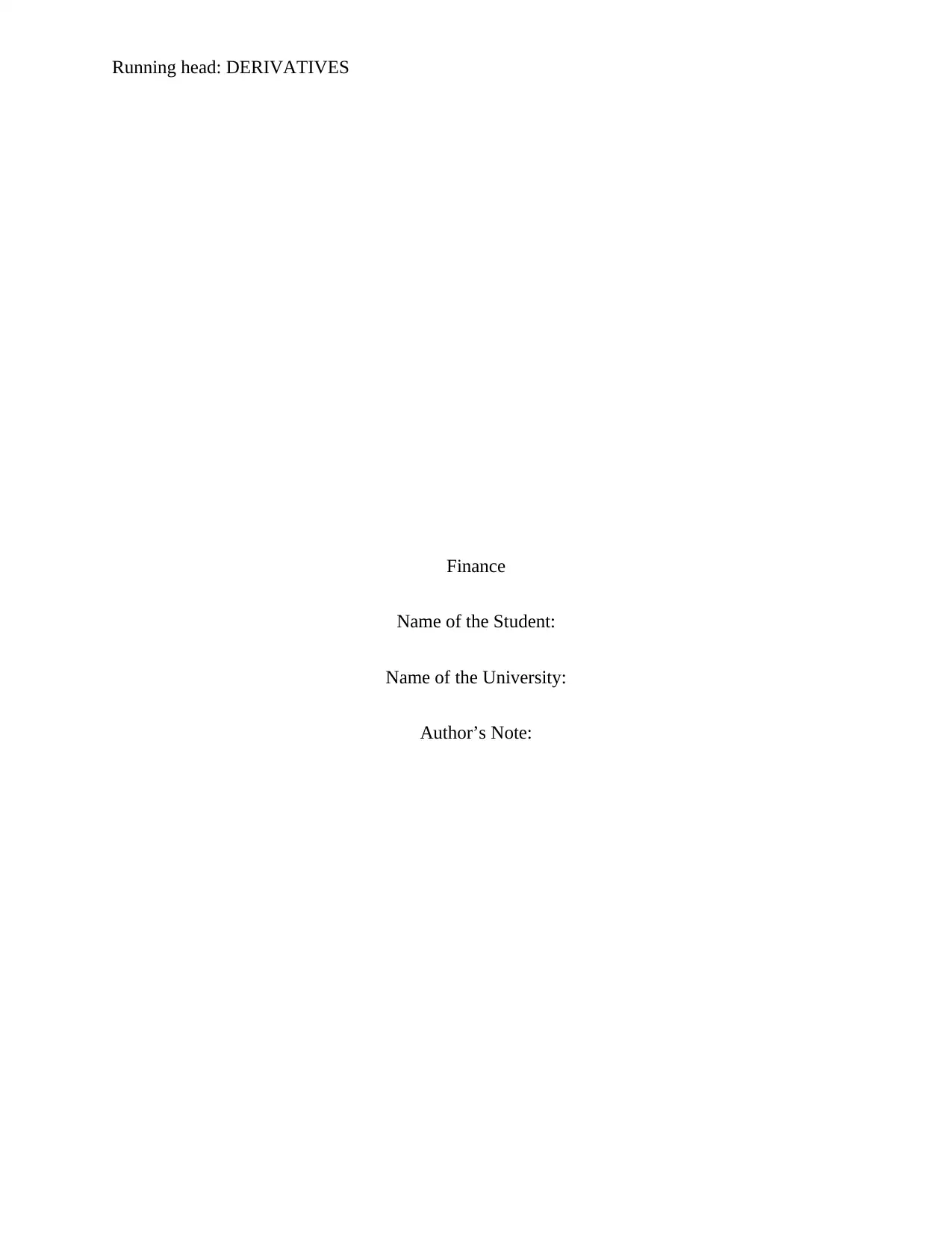
Running head: DERIVATIVES
Finance
Name of the Student:
Name of the University:
Author’s Note:
Finance
Name of the Student:
Name of the University:
Author’s Note:
Paraphrase This Document
Need a fresh take? Get an instant paraphrase of this document with our AI Paraphraser

1DERIVATIVES
Table of Contents
Question 2........................................................................................................................................2
References........................................................................................................................................6
Table of Contents
Question 2........................................................................................................................................2
References........................................................................................................................................6
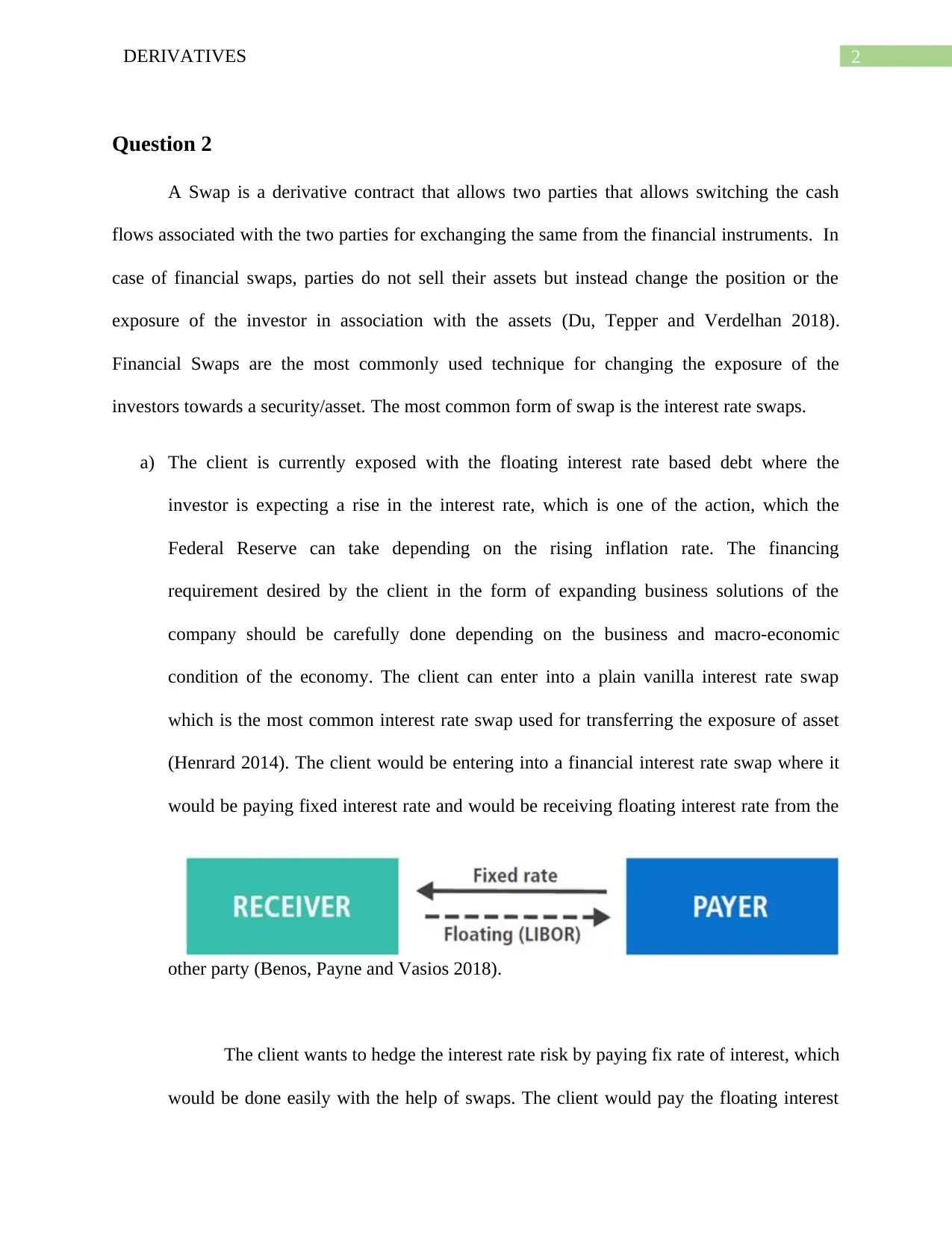
2DERIVATIVES
Question 2
A Swap is a derivative contract that allows two parties that allows switching the cash
flows associated with the two parties for exchanging the same from the financial instruments. In
case of financial swaps, parties do not sell their assets but instead change the position or the
exposure of the investor in association with the assets (Du, Tepper and Verdelhan 2018).
Financial Swaps are the most commonly used technique for changing the exposure of the
investors towards a security/asset. The most common form of swap is the interest rate swaps.
a) The client is currently exposed with the floating interest rate based debt where the
investor is expecting a rise in the interest rate, which is one of the action, which the
Federal Reserve can take depending on the rising inflation rate. The financing
requirement desired by the client in the form of expanding business solutions of the
company should be carefully done depending on the business and macro-economic
condition of the economy. The client can enter into a plain vanilla interest rate swap
which is the most common interest rate swap used for transferring the exposure of asset
(Henrard 2014). The client would be entering into a financial interest rate swap where it
would be paying fixed interest rate and would be receiving floating interest rate from the
other party (Benos, Payne and Vasios 2018).
The client wants to hedge the interest rate risk by paying fix rate of interest, which
would be done easily with the help of swaps. The client would pay the floating interest
Question 2
A Swap is a derivative contract that allows two parties that allows switching the cash
flows associated with the two parties for exchanging the same from the financial instruments. In
case of financial swaps, parties do not sell their assets but instead change the position or the
exposure of the investor in association with the assets (Du, Tepper and Verdelhan 2018).
Financial Swaps are the most commonly used technique for changing the exposure of the
investors towards a security/asset. The most common form of swap is the interest rate swaps.
a) The client is currently exposed with the floating interest rate based debt where the
investor is expecting a rise in the interest rate, which is one of the action, which the
Federal Reserve can take depending on the rising inflation rate. The financing
requirement desired by the client in the form of expanding business solutions of the
company should be carefully done depending on the business and macro-economic
condition of the economy. The client can enter into a plain vanilla interest rate swap
which is the most common interest rate swap used for transferring the exposure of asset
(Henrard 2014). The client would be entering into a financial interest rate swap where it
would be paying fixed interest rate and would be receiving floating interest rate from the
other party (Benos, Payne and Vasios 2018).
The client wants to hedge the interest rate risk by paying fix rate of interest, which
would be done easily with the help of swaps. The client would pay the floating interest
⊘ This is a preview!⊘
Do you want full access?
Subscribe today to unlock all pages.

Trusted by 1+ million students worldwide
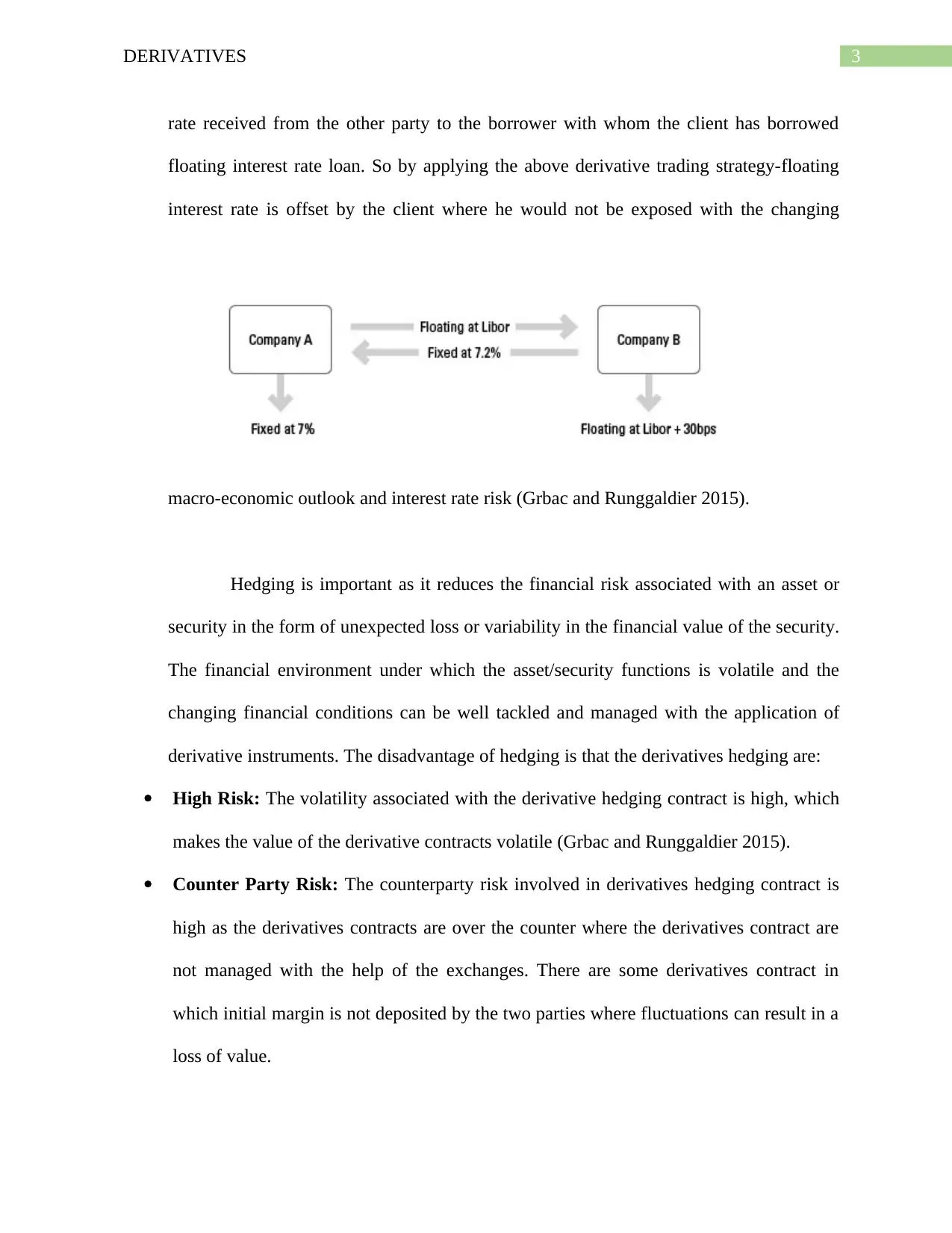
3DERIVATIVES
rate received from the other party to the borrower with whom the client has borrowed
floating interest rate loan. So by applying the above derivative trading strategy-floating
interest rate is offset by the client where he would not be exposed with the changing
macro-economic outlook and interest rate risk (Grbac and Runggaldier 2015).
Hedging is important as it reduces the financial risk associated with an asset or
security in the form of unexpected loss or variability in the financial value of the security.
The financial environment under which the asset/security functions is volatile and the
changing financial conditions can be well tackled and managed with the application of
derivative instruments. The disadvantage of hedging is that the derivatives hedging are:
High Risk: The volatility associated with the derivative hedging contract is high, which
makes the value of the derivative contracts volatile (Grbac and Runggaldier 2015).
Counter Party Risk: The counterparty risk involved in derivatives hedging contract is
high as the derivatives contracts are over the counter where the derivatives contract are
not managed with the help of the exchanges. There are some derivatives contract in
which initial margin is not deposited by the two parties where fluctuations can result in a
loss of value.
rate received from the other party to the borrower with whom the client has borrowed
floating interest rate loan. So by applying the above derivative trading strategy-floating
interest rate is offset by the client where he would not be exposed with the changing
macro-economic outlook and interest rate risk (Grbac and Runggaldier 2015).
Hedging is important as it reduces the financial risk associated with an asset or
security in the form of unexpected loss or variability in the financial value of the security.
The financial environment under which the asset/security functions is volatile and the
changing financial conditions can be well tackled and managed with the application of
derivative instruments. The disadvantage of hedging is that the derivatives hedging are:
High Risk: The volatility associated with the derivative hedging contract is high, which
makes the value of the derivative contracts volatile (Grbac and Runggaldier 2015).
Counter Party Risk: The counterparty risk involved in derivatives hedging contract is
high as the derivatives contracts are over the counter where the derivatives contract are
not managed with the help of the exchanges. There are some derivatives contract in
which initial margin is not deposited by the two parties where fluctuations can result in a
loss of value.
Paraphrase This Document
Need a fresh take? Get an instant paraphrase of this document with our AI Paraphraser

4DERIVATIVES
Speculation: Derivative contracts are sometimes regarded as a speculation where clients
use the same for speculating the price movement. Due to the risky nature of financial
assets, it is regarded that the financial asset should be an underlying asset for reducing
the overall financial risk of the asset/security.
It is crucial to note that hedging and speculation are two different aspects. It is advised that
the financial risk associated with a security or asset needs to be hedged so that the unwanted
loss or extreme volatility in the financial market could be hedged.
b) Interest Rate Caps are common interest rate derivatives that are used for the purpose of
the hedging the risk associated with the interest rate movement in the market. The interest
rate cap are used for the purpose of hedging or restricting the movement of the interest
beyond a certain level. The interest rate caps are well effective when the interest rate
exceeds a certain level then the cap buyer who is buying the protection will be
compensated by the excess of interest rate level over the strike price (Laurence 2017).
The client could buy the interest rate swap for protecting or hedging the interest rate risk.
The client is worried about the rise in the floating exchange rate upon which the
borrowings of the client is based that can be easily hedged by buying interest rate caps.
Interest rate Caps can also be considered as a call option on the interest rate where if the
interest rate rise well above a certain range then the cap buyer would be compensated in
the form of over and excess rise in the interest rate level (Deutsch 2016). The client is
exposed with the floating interest rate risk where rising interest rate risk can significantly
influence the financial position of the client. If the interest rate does not rise well above a
certain level then the option or the cap lapses and the payoff from the cap would be zero.
Speculation: Derivative contracts are sometimes regarded as a speculation where clients
use the same for speculating the price movement. Due to the risky nature of financial
assets, it is regarded that the financial asset should be an underlying asset for reducing
the overall financial risk of the asset/security.
It is crucial to note that hedging and speculation are two different aspects. It is advised that
the financial risk associated with a security or asset needs to be hedged so that the unwanted
loss or extreme volatility in the financial market could be hedged.
b) Interest Rate Caps are common interest rate derivatives that are used for the purpose of
the hedging the risk associated with the interest rate movement in the market. The interest
rate cap are used for the purpose of hedging or restricting the movement of the interest
beyond a certain level. The interest rate caps are well effective when the interest rate
exceeds a certain level then the cap buyer who is buying the protection will be
compensated by the excess of interest rate level over the strike price (Laurence 2017).
The client could buy the interest rate swap for protecting or hedging the interest rate risk.
The client is worried about the rise in the floating exchange rate upon which the
borrowings of the client is based that can be easily hedged by buying interest rate caps.
Interest rate Caps can also be considered as a call option on the interest rate where if the
interest rate rise well above a certain range then the cap buyer would be compensated in
the form of over and excess rise in the interest rate level (Deutsch 2016). The client is
exposed with the floating interest rate risk where rising interest rate risk can significantly
influence the financial position of the client. If the interest rate does not rise well above a
certain level then the option or the cap lapses and the payoff from the cap would be zero.
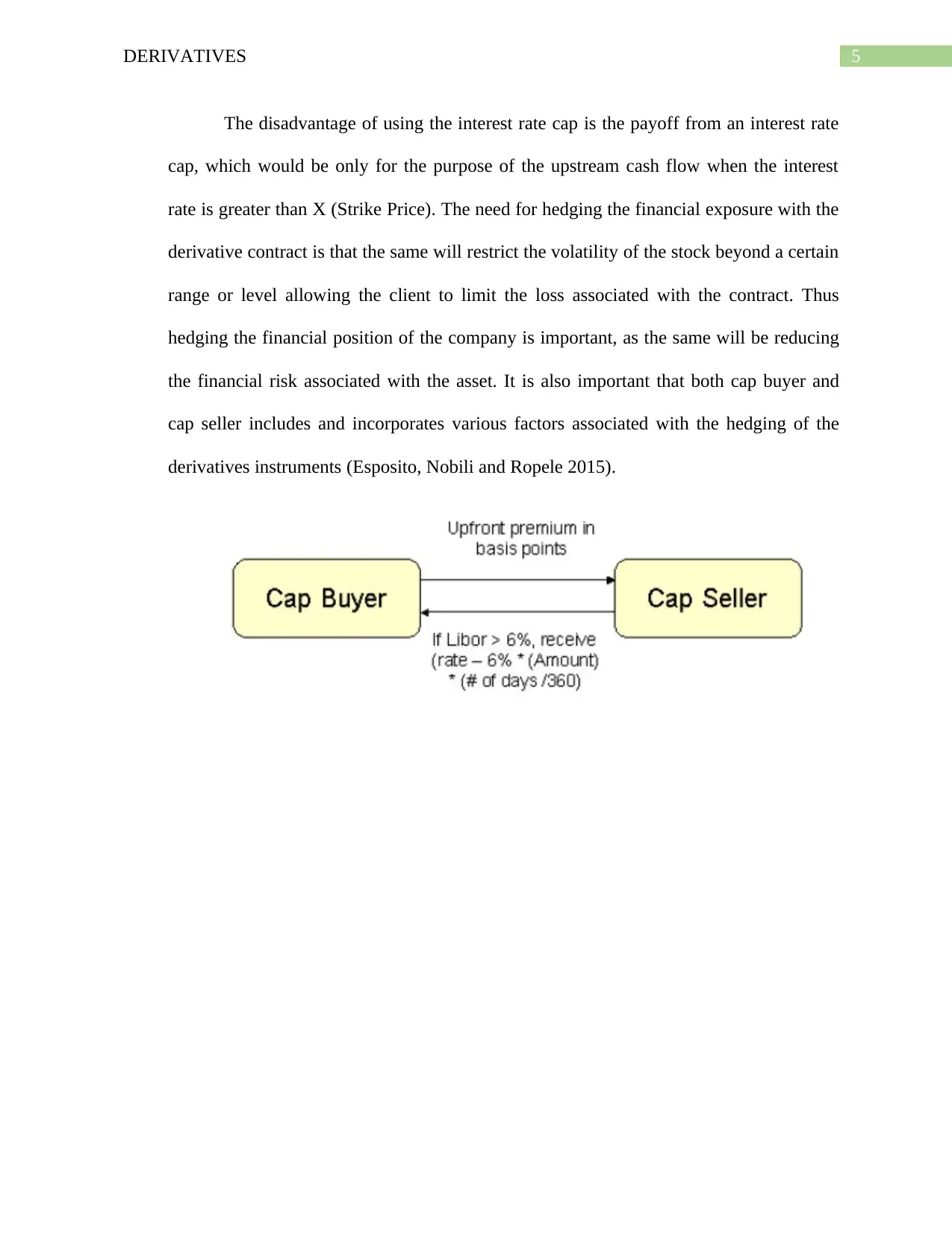
5DERIVATIVES
The disadvantage of using the interest rate cap is the payoff from an interest rate
cap, which would be only for the purpose of the upstream cash flow when the interest
rate is greater than X (Strike Price). The need for hedging the financial exposure with the
derivative contract is that the same will restrict the volatility of the stock beyond a certain
range or level allowing the client to limit the loss associated with the contract. Thus
hedging the financial position of the company is important, as the same will be reducing
the financial risk associated with the asset. It is also important that both cap buyer and
cap seller includes and incorporates various factors associated with the hedging of the
derivatives instruments (Esposito, Nobili and Ropele 2015).
The disadvantage of using the interest rate cap is the payoff from an interest rate
cap, which would be only for the purpose of the upstream cash flow when the interest
rate is greater than X (Strike Price). The need for hedging the financial exposure with the
derivative contract is that the same will restrict the volatility of the stock beyond a certain
range or level allowing the client to limit the loss associated with the contract. Thus
hedging the financial position of the company is important, as the same will be reducing
the financial risk associated with the asset. It is also important that both cap buyer and
cap seller includes and incorporates various factors associated with the hedging of the
derivatives instruments (Esposito, Nobili and Ropele 2015).
⊘ This is a preview!⊘
Do you want full access?
Subscribe today to unlock all pages.

Trusted by 1+ million students worldwide
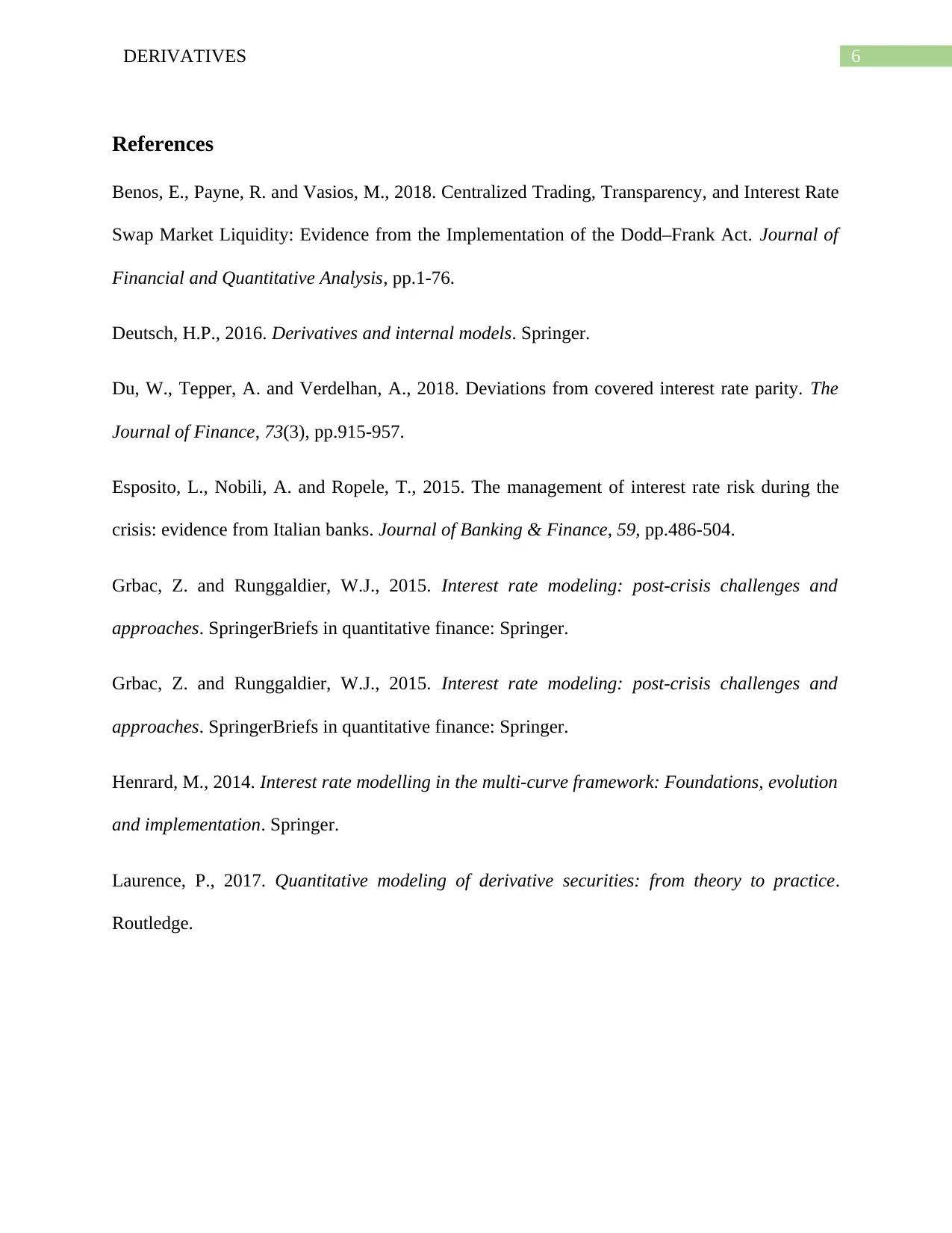
6DERIVATIVES
References
Benos, E., Payne, R. and Vasios, M., 2018. Centralized Trading, Transparency, and Interest Rate
Swap Market Liquidity: Evidence from the Implementation of the Dodd–Frank Act. Journal of
Financial and Quantitative Analysis, pp.1-76.
Deutsch, H.P., 2016. Derivatives and internal models. Springer.
Du, W., Tepper, A. and Verdelhan, A., 2018. Deviations from covered interest rate parity. The
Journal of Finance, 73(3), pp.915-957.
Esposito, L., Nobili, A. and Ropele, T., 2015. The management of interest rate risk during the
crisis: evidence from Italian banks. Journal of Banking & Finance, 59, pp.486-504.
Grbac, Z. and Runggaldier, W.J., 2015. Interest rate modeling: post-crisis challenges and
approaches. SpringerBriefs in quantitative finance: Springer.
Grbac, Z. and Runggaldier, W.J., 2015. Interest rate modeling: post-crisis challenges and
approaches. SpringerBriefs in quantitative finance: Springer.
Henrard, M., 2014. Interest rate modelling in the multi-curve framework: Foundations, evolution
and implementation. Springer.
Laurence, P., 2017. Quantitative modeling of derivative securities: from theory to practice.
Routledge.
References
Benos, E., Payne, R. and Vasios, M., 2018. Centralized Trading, Transparency, and Interest Rate
Swap Market Liquidity: Evidence from the Implementation of the Dodd–Frank Act. Journal of
Financial and Quantitative Analysis, pp.1-76.
Deutsch, H.P., 2016. Derivatives and internal models. Springer.
Du, W., Tepper, A. and Verdelhan, A., 2018. Deviations from covered interest rate parity. The
Journal of Finance, 73(3), pp.915-957.
Esposito, L., Nobili, A. and Ropele, T., 2015. The management of interest rate risk during the
crisis: evidence from Italian banks. Journal of Banking & Finance, 59, pp.486-504.
Grbac, Z. and Runggaldier, W.J., 2015. Interest rate modeling: post-crisis challenges and
approaches. SpringerBriefs in quantitative finance: Springer.
Grbac, Z. and Runggaldier, W.J., 2015. Interest rate modeling: post-crisis challenges and
approaches. SpringerBriefs in quantitative finance: Springer.
Henrard, M., 2014. Interest rate modelling in the multi-curve framework: Foundations, evolution
and implementation. Springer.
Laurence, P., 2017. Quantitative modeling of derivative securities: from theory to practice.
Routledge.
1 out of 7
Related Documents
Your All-in-One AI-Powered Toolkit for Academic Success.
+13062052269
info@desklib.com
Available 24*7 on WhatsApp / Email
![[object Object]](/_next/static/media/star-bottom.7253800d.svg)
Unlock your academic potential
Copyright © 2020–2025 A2Z Services. All Rights Reserved. Developed and managed by ZUCOL.





